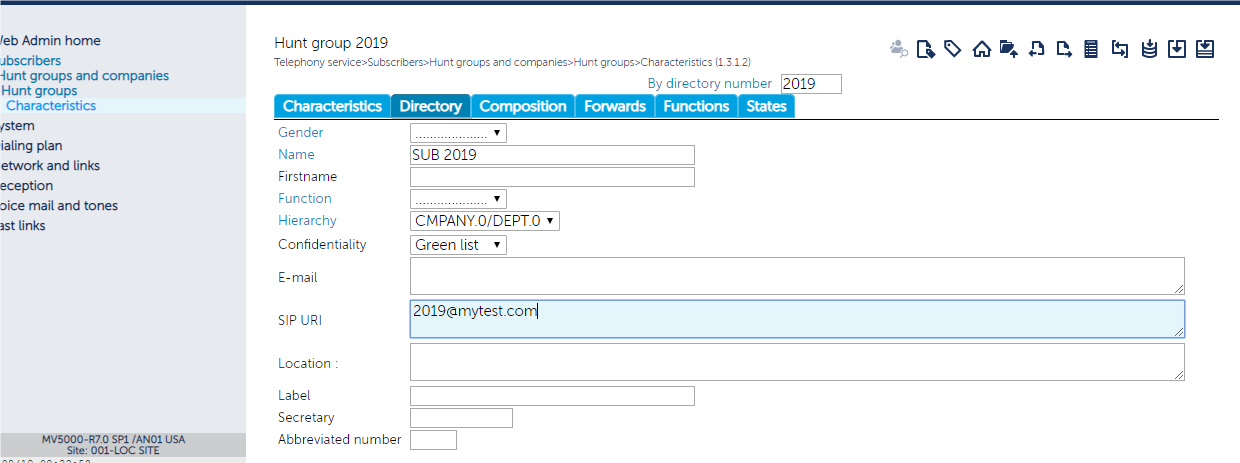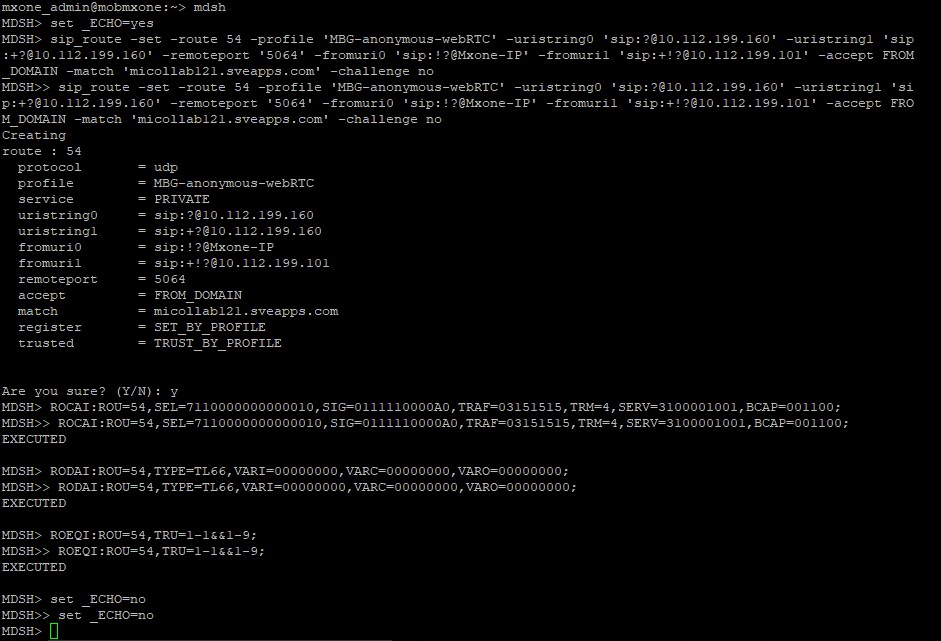
As a MiCollab user in Audio, Web and Video conference (AWV), with the introduction of the feature of two-way audio mode, the user can use the AWV web client for two-way audio functionality, similar to an AWV desktop client.
This topic provides instructions on how to integrate and configure the two-way audio feature with the supported PBXs.
The user will see the two-way audio option in AWV web client if the feature is configured on the MiCollab server and if the WebRTC supported browsers and operating systems are used. AWV web client uses MiVoice Border Gateway (MBG) anonymous call WebRTC capability.
Two-way audio integration with MiCollab is a three-step process:
AWV Configuration
MBG Configuration
PBX Configuration
Note: The supported platforms for two-way audio are MiVoice Business, MiVoice 5000, and MX-One.
Note: The two-way audio on MX-One is supported only on Standalone MBG.
Note: The MBG WebRTC settings should be configured on AWV for the two-way audio to work.
Note: MBG should be provisioned with an additional RAM and CPU for proper functioning of two-way audio WebRTC calls. For more information on memory and CPU usage, see MiCollab Engineering Guidelines > MiVoice Border Gateway Guidelines section.
Component |
Requirement |
Mobile Device Operating System |
Android (Mobile/Tablets) |
Web Browser |
|
Operating System |
|
Devices |
Surface Pro |
Configure the following fields for MBG WebRTC Settings under Server Manager > Audio, Web and Video Conferencing > Configuration > Two-Way Audio Settings.
MBG Server Name - Enter the name of the MBG server.
MBG WebRTC Port - Enter the port number of WebRTC. The default value of MBG WebRTC port is 5063.
Web Server Shared Secret - This value should be same as the WebRTC value for MBG configuration.
SIP URI - Enter the SIP URI details from the MiVoice 5000 PBX configuration. Note that this field is case sensitive. This field is visible only when MiVoice 5000 is selected.
Note: The AWV hunt group number of PBX should be configured under Dial-In Phone Number 1 field which is present in system options of AWV admin portal.
To view and update the MBG WebRTC settings, see Server Manager > MiVoice Border Gateway > Teleworking > WebRTC.
Log in to MiCollab Server Manager and navigate to MiVoice Border Gateway >Teleworking >WebRTC.
Select the Enabled checkbox to enable the WebRTC Service.
Under Licenses,
make sure you have active Anonymous
calls licenses. If this value is “0” then purchase the following
license from AMC and sync MiCollab licenses.
“MBG: 1 SIP Trunking Channel
License”.
Change the Hosting mode to anonymous and subscriber.
Configure the Webserver shared secret password.
Click Save
For detailed description of WebRTC settings, see Configuration > WebRTC section in the MBG online help document.
The SIP trunking configurations on different PBX is explained in below sections:
Note: Make sure SIP trunk is established between MBG and the PBX, and anonymous call is allowed in the PBX.
3.1 MiVoice Business Configuration
In the MiVoice Business System Administration Tool, click View by Category.
Add licenses using the following procedure:
Access the License and Options Selection form.
Under Trunking Networking, enter the number of SIP Trunk licenses for your implementation. This is the maximum number of concurrent trunk sessions that can be configured.
Configure a network element for MBG:
Access the Network Elements form and add a new entry.
Configure the following fields:
Field |
Description |
| Name | Enter a unique name of up to nine characters for the network element (e.g. WebRTC). |
| Type | Select Other. |
| FQDN or IP Address | Enter the LAN IP address of MBG, provided that MBG is operating in Server-Gateway mode. |
Record the network element Name. You will require it in step 5, below.
Select the SIP Peer check box and configure the following fields:
Field |
Description |
| SIP Peer Transport | Select UDP |
| SIP Peer Port | Enter 5064 |
| SIP Peer Status | Select Always Active |
Click Save.
Configure the SIP trunk attributes:
Access the Trunk Attributes form and select a trunk service number that is available to be changed.
Configure the following fields:
Field |
Description |
| Non-Dial-In Trunks Answer Point - Day | Enter the destination number (answer point) to which incoming WebRTC trunk calls are routed during the Day service. This can be a station, hunt group pilot number, DISA number, or System Speed call number on the ICP. |
| Non-Dial-In Trunks Answer Point - Night 1 | Enter the same value as specified above. |
| Non-Dial-In Trunks Answer Point - Night 2 | Enter the same value as specified above. |
| Trunk Label | (Optional) Enter the character string to identify the trunk. |
| Note:
For anonymous mode WebRTC calls, the trunk must use the same answer
point for each mode of service.
|
|
Access the SIP Peer Profile form and add a new entry.
Configure the following fields:
Field |
Description |
| SIP Peer Profile Label | Enter the name of the network element (e.g. WebRTC). |
| Network Element | Select the network element that you created for the MBG |
| Address Type | Select IP Address |
| Trunk Service | Enter the SIP Trunk Service Number that you modified in the previous step. |
Click Save.
Record the SIP Peer Profile Label. You will require it in the next step.
Configure the SIP Peer Profile Assignment by Incoming DID:
Access the SIP Peer Profile Assignment by Incoming DID form and add a new entry.
Configure the following fields:
Field |
Description |
| Incoming DID Range | Enter the destination number (answer point) to which incoming WebRTC trunk calls are routed on the ICP. |
| SIP Peer Profile Label | Select the SIP Peer Profile Label that you added in the previous step. |
Click Save.
3.2 MiVoice 5000 Configuration
Log-in to the MVoice 5000, navigate to
Dialing Plan > Direction names and configure
the Associated direction.
Enter the Private direction value in the textbox (for example, DIR_SIP).

Navigate to Dialing Plan > Plan for Internet links > Access to specific domains, enter the domain name or IP address under the Domain/IP Address 1 textbox (for example, mytest.com).

Navigate to the Trunk Group. In the Trunk group selection page, click on the Select the item button.

Select the following fields:
Signaling type as SIP.
Subtype as Internet Link.
Click the Characteristics button.

Enter the values as displayed in the screenshots below (for example, IP address: MBG’s IP) and then click the Advanced mode icon (on top of the page) to view and configure the settings.


Open the Hunt group page and enter the SIP URI details AWVHuntGroup@mytest.com) as shown below:

3.3 MiVoice MX-One Configuration
Note: The two-way audio on MX-One is supported only on Standalone MBG.
Run the below commands on MX-One server (using MDSH commands) for creating SIP trunking between MX-One and MBG. Fill MBG-IP, MX-One-IP, MBG’s FQDN, and RouteNo (any free Route) values in below mentioned commands:
set _ECHO=yes
sip_route -set -route RouteNo-profile 'MBG-anonymous-webRTC' -uristring0 'sip:?@MBG-IP' -uristring1 'sip:+?@MBG-IP' -remoteport '5064' -fromuri0 'sip:!?@Mxone-IP' -fromuri1 'sip:+!?@Mxone-IP' -accept FROM_DOMAIN -match 'MBG's FQDN' -challenge no
ROCAI:ROU=RouteNo,SEL=7110000000000010,SIG=0111110000A0,TRAF=03151515,TRM=4,SERV=3100001001,BCAP=001100;
RODAI:ROU=RouteNo,TYPE=TL66,VARI=00000000,VARC=00000000,VARO=00000000;
ROEQI:ROU=RouteNo,TRU=1-1&&1-9;
set _ECHO=no

In the Two-Way Audio Settings page, when you click the Reset option, the following changes take place:
In the Server Manager page, under Application click on Audio, Web and Video Conferencing.
Click on the Two-Way Audio Settings.
In Two-Way Audio Settings page, click on the Reset button.
A warning message is displayed, which states that resetting will restart the call server, resulting in the loss of all the current calls.
Click OK to confirm or click Cancel to terminate the task.
Scenarios for AWV Web Client errors
| Sl No | AWV WebClient Error Messages Reported by User | Possible correction steps for Admin/User |
| 1 | Failed to reach MBG audio gateway. Please check your network connection and try again. If problem persists, contact the administrator. |
|
| 2 | MBG audio gateway authentication has failed, please contact the administrator. |
|
| 3 | Failed to establish connection with MBG audio gateway. Please try again. If problem persists, contact the administrator. |
|
| 4 | An error occurred while joining the audio. Please refresh your browser and try again. If problem persists, contact administrator. |
|
| 5 | No audio device detected on system. Please check your system audio settings and try again. |
|
| 6 | User reports about audio getting silent in an on-going call |
|
To know more about on how to configure WebRTC on MBG and configure ICP for WebRTC, see Configure ICP for WebRTC and Configure MBG for WebRTC.
Refer the MiCollab Engineering Guidelines for MBG hardware resource requirement for supporting WebRTC Audio Calls in AWV.